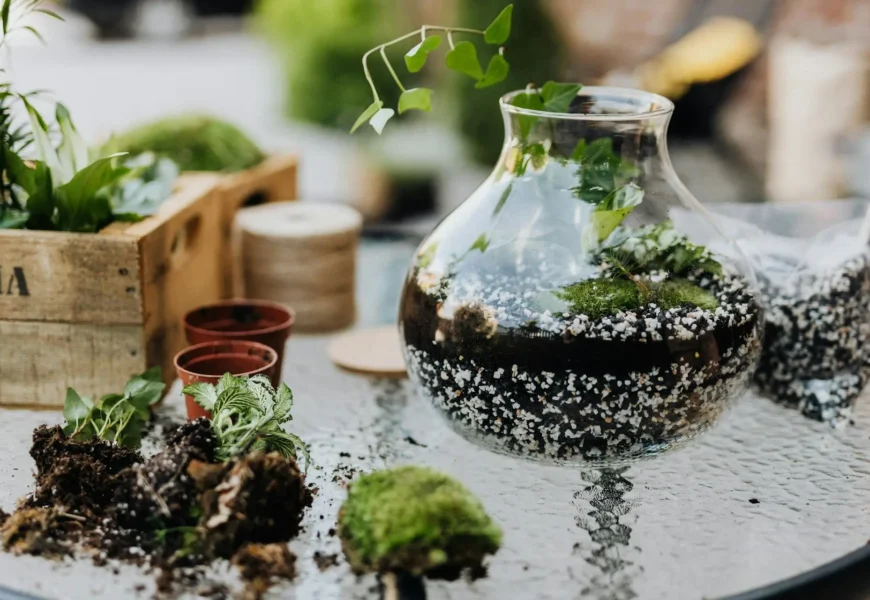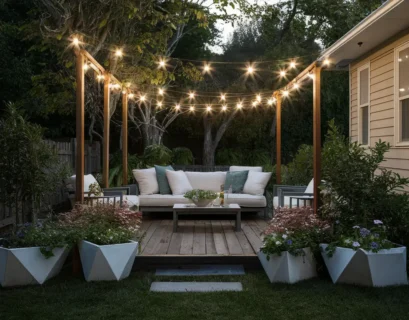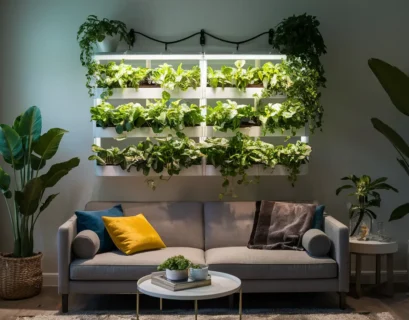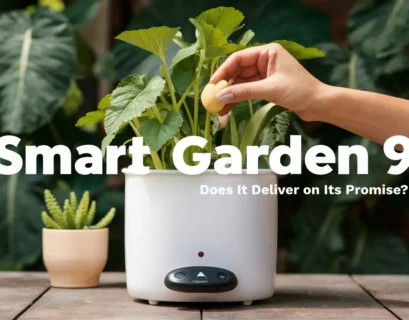Building healthy soil is the foundation of a flourishing garden. But who says nourishing your plants has to break the bank? Secret number three in our “Gorgeous Gardens on a Shoestring” series unlocks the power of DIY mulch and compost! Let’s dive into creating free, nutrient-rich amendments to supercharge your soil.
The Magic of Mulch:
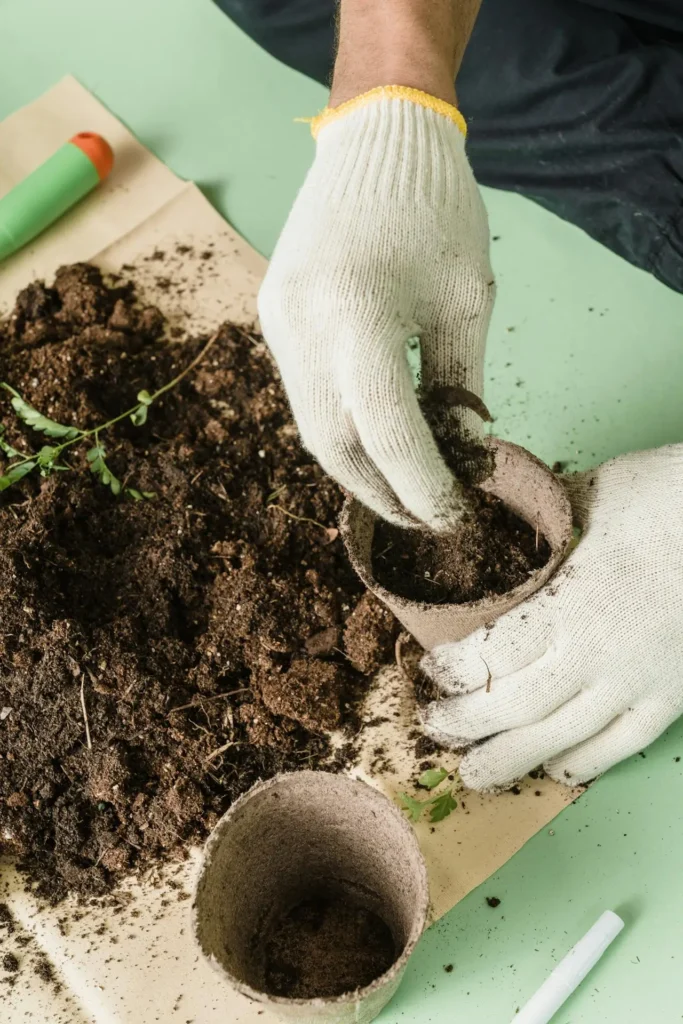
Mulch is a layer of material spread around the base of your plants. It offers a wealth of benefits:
Moisture Retention:
- Reduced Watering Frequency: Mulch acts like a blanket, minimizing water evaporation from the soil surface. This can translate to significantly fewer watering sessions per week, especially during hot and dry periods.
- Less Water Waste: By preventing water from quickly evaporating, mulch ensures that precious moisture reaches plant roots where it’s needed most. This reduces water waste and saves you money on your water bill.
- Improved Soil Moisture Consistency: Mulch helps regulate soil moisture levels, preventing the soil from drying out too quickly after watering or rain. This creates a more consistent moisture environment for your plants, promoting healthy growth.
Weed Suppression:
- Blocks Light Penetration: Mulch creates a physical barrier that prevents sunlight from reaching weed seeds in the soil. Without sunlight, weed seeds remain dormant and unable to germinate, significantly reducing weed growth in your garden beds.
- Smothering Existing Weeds: A thick layer of mulch can smother existing weeds by blocking sunlight and preventing them from accessing essential resources for growth. This eliminates the need for harsh herbicides and saves you time spent weeding.
- Reduces Favorable Germination Conditions: Weed seeds often require bare soil and fluctuating temperatures for optimal germination. Mulch creates a more stable environment with cooler soil temperatures and less exposure to sunlight, making it less hospitable for weed seed germination.
Temperature Regulation:
- Cooler Summer Soils: During hot summer months, mulch acts as an insulator, shading the soil surface and preventing it from absorbing excessive heat. This keeps the root zone cooler, reducing stress on your plants and promoting healthy root development.
- Warmer Winter Soils: In colder climates, mulch acts as a protective layer, helping to retain heat in the soil. This insulates plant roots from freezing temperatures and protects them during harsh winter conditions.
Soil Enrichment:
- Gradual Release of Nutrients: As mulch decomposes over time, it releases valuable nutrients like nitrogen, phosphorus, and potassium back into the soil. This natural process improves soil fertility and provides a continuous source of nutrients for your plants.
- Enhanced Soil Structure: The decomposition of organic mulch materials like leaves, bark, or wood chips helps improve soil structure. This creates better aeration and drainage, allowing for optimal root growth and water infiltration.
- Increased Water Holding Capacity: Decomposing mulch adds organic matter to the soil, which acts like a sponge, increasing the soil’s ability to hold water. This translates to less frequent watering needs and improved overall plant health.
DIY Mulch on a Budget:
Here’s a breakdown of the top DIY mulch options, highlighting their unique benefits and best practices for use:
1. Shredded Leaves:
- Pros: Easily obtainable for free in autumn, beautiful natural aesthetic, readily available in most regions. Shredded leaves decompose relatively quickly, adding organic matter and nutrients to the soil.
- Cons: May require shredding with a lawn mower or leaf shredder for optimal use. Can pack down over time, potentially reducing airflow to the soil.
- Best Use: Ideal for flower beds, around trees and shrubs, or as a top layer in a lasagna mulching system (alternating layers of green and brown materials).
2. Grass Clippings:
- Pros: Readily available and free if you mow your own lawn. Fresh grass clippings add a good dose of nitrogen to the soil as they decompose.
- Cons: Decomposes quickly, requiring more frequent reapplication. Can clump together if not spread in a thin layer, potentially smothering plants and attracting pests. Avoid using clippings from lawns treated with herbicides.
- Best Use: Use in a thin layer (no more than 2 inches) around established plants. Monitor closely and turn occasionally to prevent clumping. Not recommended for vegetable gardens due to potential weed seed contamination.
3. Straw or Hay:
- Pros: Very affordable and readily available at garden centers or farms. Offers a rustic aesthetic and provides excellent weed suppression. Straw decomposes slower than leaves or grass clippings, offering long-term benefits.
- Cons: May contain weed seeds, so ensure you are using weed-free straw or hay. Can initially repel water due to its waxy coating, so watering may need to be adjusted.
- Best Use: Perfect for pathways, around ornamental plants, or in vegetable gardens (use a weed-free option). Apply a thin layer initially, adding more as needed to maintain weed suppression.
4. Wood Chips:
- Pros: A very affordable option, often available for free through freecycle programs or tree services. Provides excellent weed suppression and long-lasting mulch benefits.
- Cons: Large wood chips decompose slowly, adding little nitrogen to the soil initially. May cause temporary nitrogen depletion as microorganisms compete for nitrogen during decomposition.
- Best Use: Ideal for pathways, around trees and shrubs, or in areas with established perennial plantings. Avoid using directly around vegetable gardens due to potential nitrogen depletion. If using near vegetable gardens, consider mixing with other mulch materials or pre-composting the wood chips to reduce nitrogen depletion.
Composting Magic:
Composting transforms kitchen scraps and yard waste into nutrient-rich food for your plants. Here’s a breakdown of the essential steps to get your free compost bin up and running:
1. Crafting Your Compost Bin:
- Repurpose & Recycle: Look around your yard or local freecycle groups for free or low-cost materials. Wooden pallets offer a sturdy and customizable option. Chicken wire can be used to create freestanding cylindrical bins, or to enclose an existing wooden frame.
- Upcycle an Old Trash Can: A well-ventilated trash can with a removable lid can be a simple and effective compost bin. Drill holes in the sides and bottom of the can to allow for airflow and drainage. Ensure the lid allows for some ventilation as well.
- Build It Yourself: If you’re feeling creative, there are numerous online resources with DIY compost bin plans. Utilize recycled wood or cinderblocks to create a multi-chambered bin system for faster composting.
2. The Art of Layering:
- Green Materials: These nitrogen-rich ingredients provide the “fuel” for your compost pile. Examples include food scraps like fruit and vegetable peels, coffee grounds, tea bags, and eggshells.
- Brown Materials: These carbon-rich ingredients provide structure and balance the moisture content in the pile. Include shredded paper, cardboard (avoid glossy or colored varieties), dried leaves, twigs, and straw.
- Finding the Perfect Balance: A good rule of thumb is to aim for a 3:1 ratio of brown to green materials. This ensures optimal decomposition rates and prevents the pile from becoming too wet or odorous.
3. Turning for Aeration:
- The Importance of Oxygen: Composting is an aerobic process, meaning it requires oxygen to break down organic materials efficiently. Regularly turning your compost pile allows for proper aeration.
- Breaking Up Clumps: Turning also helps break up clumps and ensures all materials are exposed to oxygen and moisture. This promotes faster decomposition and prevents the center of the pile from becoming anaerobic (without oxygen), which can create unpleasant odors.
- Frequency of Turning: Aim to turn your compost pile with a shovel or pitchfork every few weeks, or more frequently if the pile seems wet or compacted.
Bonus Tip
Moisture is Key: Maintain a consistent moisture level in your compost pile. It should feel like a damp sponge. Add water if the pile feels dry, and turn it to aerate if it becomes soggy.
Conclusion:
By creating your own mulch and compost, you’ll save money, reduce waste, and nourish your garden with the goodness of nature’s free bounty. In the next chapter of “Gorgeous Gardens on a Shoestring” we’ll explore the art of upcycling and repurposing for creative and affordable garden features. Stay tuned!

